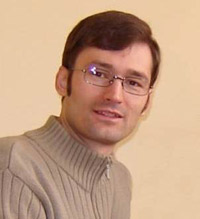
Nume: IACOB Dumitru Dan
Tema: Discurs literar-artistic şi construcţie identitară în secolele XVI-XX
Partener: Academia Română, Filiala Iaşi Institutul de Istorie A.D. Xenopol, Iaşi
Proiect: Public Space and Social Identity in the Romanian Town. From the First Half of 19th Century
Date de contact:
danyakob@yahoo.com
Profil
I’m researcher at the Institute for Studies in Social Sciences and Humanities from Sibiu (Romanian Academy) and my scientific area of interest is urban and social history of Moldavia and Walachia / Romania in the 19th century. My Ph.D thesis is The elite from Romanian Principalities at the middle of the 19th century. Life style and menthalities (2008). I’m coordinator of Historical Atlas of the Towns from Romania and secretary of the board at Historia Urbana journal. Since 1999, I have been member in the Commission for the History of Towns in Romania of the Romanian Academy. Beginning with 2009, I’m associated professor at “Lucian Blaga” University from Sibiu, where I’m teaching two courses and two seminars about the elite’s history and the history of daily life in Modern Period, at master level. Some of the courses’ topics are about urban civilization and modernizations of Romanian towns from extra Carpathian area. I have published five fascicles of the Atlas and over 20 articles of urban and social history in the last ten years.
Public Space and Social Identity in the Romanian Town. From the First Half of 19th Century
Public space is an important barometer of urban life, through its representative functions and values, because it is a preeminently 'scenic' space, it is a space of social and cultural show. From social standpoint, under various aspects (streets, markets, public walks, public gardens, theatre, restaurants, coffee houses, confectioners, ball and concert public rooms, clubs, reading rooms), public space reveals sequences about “daily practices, private experiences, solidarities and fights which organize the space” (L. Girard, P. Mayol, C. Ghiţulescu), about reinventing the daily occurrence (M. Certeau), fashionable sociability, (M. Agulhon), symbols and social behaviors of these spaces.
On the basis of various types of sources from the 19th century, we propose to emphasize identity potential of urban public space not so much from urbanistic perspective but especially from cultural and social standpoint. We aim to pay more attention to some representative examples of public spaces, such as: the promenade, the theater hall, the market, the square and the public garden. We will also try to identify and analyze the social, cultural and symbolic functions of public spaces within literary-artistic speech, the identity of social actors who populate / use public space, the social classes / literary archetypes (the high rank boyar, the provincial, the dandy, the new rich, the Jew, the gambler) existing in public space.
Searching public space opens us new perspectives upon the appearing, evolution of the functioning mechanisms and the effects produced on social and cultural level by the relation identity-alterity. The identification of social stereotypes and urban elements which are conspicuous for the writer or artist can be an instrument for checking the importance of a certain public space. More precisely, the emphasizing of these elements can offer clues about social attraction level of public space at a certain moment, about public preferences of attending it in a favorite way or to boycott it and about its social coagulation or marginalization power.
Relevant paperworks
- Atlas istoric al oraşelor din România / Städtegeschichteatlas Rumäniens [Historical Atlas of the Towns from Romania], fasciculele Sebeş, Suceava, Târgovişte, Câmpulung şi Siret, coordinator/coauthor, Bucureşti, Editura Enciclopedică 2004–2010, ISBN: 912(498-21):94(498.3).
- "Duelul de onoare în societatea românească din secolul al XIX lea. Factori de receptare" [The duel of Honour in the Romanian Society in the 19th Century. Assimilation Agents], in Andi Mihalache and Alexandru Istrate, ed., Romantism şi modernitate. Atitudini, reevaluări, polemici [Romanticism and modernity. Attitudes, reevaluating, polemics], Iaşi, Editura Universităţii „Alexandru Ioan Cuza”, 2009, p. 419-454, ISBN: 978-973-703-403-8.
- "Măsuri de sistematizare a zonei centrale a oraşului Iaşi în prima jumătate a secolului al XIX-lea. Demolarea «baratcelor»" [Urban Planning Works of Iaşi in the First Half of 19th Century. The Demolition of Old Buildings] in Sorin Iftimi, Aurica Ichim and Lucian Lefter, ed., „Monumentul” (Lucrările Simpozionului Naţional „Monumentul – Tradiţie şi viitor”, Ediţia a X a, Iaşi, 2008), tom. X1. Iaşi, 2009, 21-55.
- "Sinagogile din Iaşi la mijlocul secolului al XIX lea (aspecte culturale, sociale, arhitectonice şi urbanistice)" [Synagogues of Iaşi at the Middle of 19th Century (Cultural, Social, Architectural and Urbanistic Aspects)], Historia Urbana 17 (2009): 119-169.
- "Balurile înaltei societăţi din Principatele Române la mijlocul secolului al XIX lea" [The Balls of High-life from Romanian Principalities at the Middle of 19th Century], in Laurenţiu Rădvan, ed., Oraşul din spaţiul românesc între Orient şi Occident. Tranziţia de la medievalitate la modernitate [The Town from Romanian Space between Orient and Western Countries], Iaşi, Editura „Universităţii Alexandru Ioan Cuza”, 2007, p. 263-324, ISBN 978-973-703-206-3.